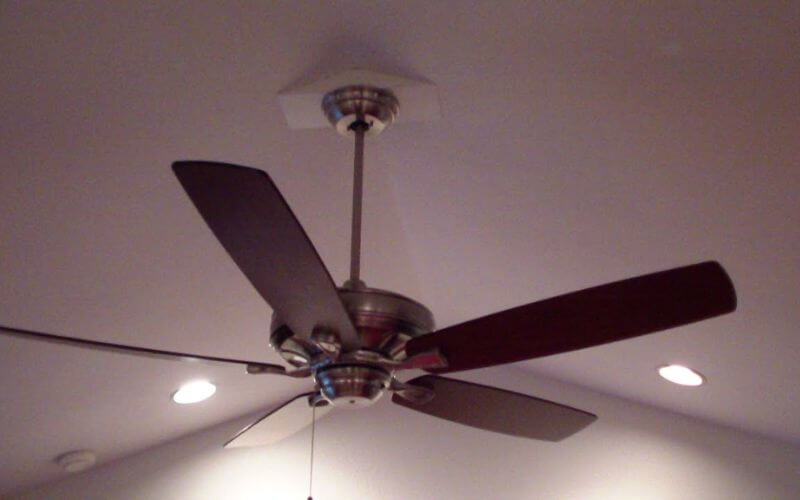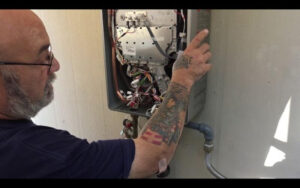The room may appear more prominent and stylish with a high vaulted ceiling. If you’re thinking about adding a fan to your room, you might be wondering if you can hang one on the vaulted ceiling. If yes, then how to install a ceiling fan on a vaulted ceiling. This post will cover the method we found for doing this.
On the vaulted ceiling, a ceiling fan can be mounted. To accomplish this, you must first check that the fan has the proper mounting hardware assembly for the vaulted ceiling. Also, a down rod must be used to secure the fan before mounting the ceiling fan on a vaulted ceiling. You can also Install The Ceiling Fan on a Sloped Ceiling. This ensures that no safety issues arise when the fan is operating.
Don’t worry if you still have concerns about mounting ceiling fans on vaulted ceilings. Here, we’ll examine the subject in more detail. Learn how to hang a ceiling fan on a vaulted ceiling and other things like whether all ceiling fans can use down rods, how low you can hang the ceiling fan from the vaulted ceiling, and more. Without further delay, let’s get going!
Table of Contents
ToggleSize Of A Vaulted Ceiling Fan:
You must ensure that the ceiling fan is appropriate for the room. Depending on the room’s height and layout, you can install a 60-90-inch fan.
Most ceiling fans include mounting hardware for either a flat or diagonal hang. The brand and model of your fan should be verified because some fans may come with an adapter that enables you to hang it at a second 45-degree angle. For your ceiling, it works. The height of the ceiling determines the down rod’s length. The down rod should typically be longer for vaulted ceilings and 7-8 feet off the ground.
Also check: Are Ceiling Fans A Fire Hazard?
| Image | Product | Features | Price |
|
Best Seller
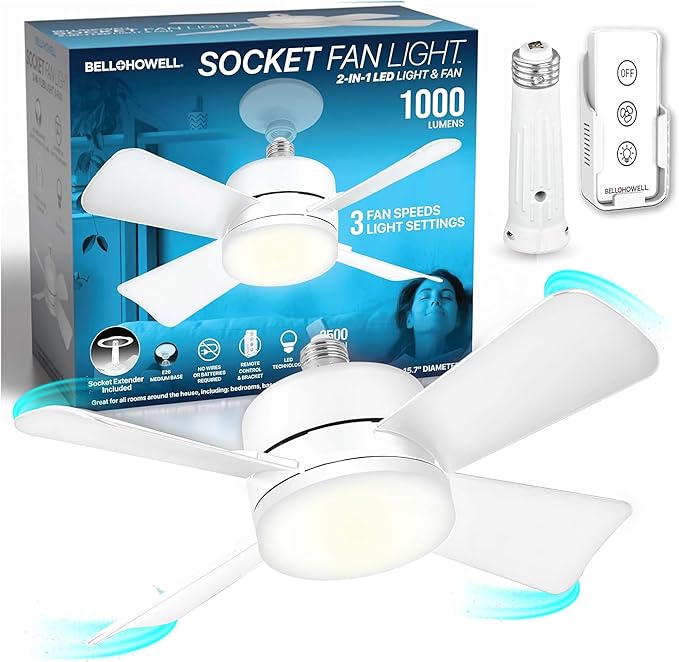
|
Socket Fan Light Original – Warm Light Ceiling Fans with Lights and Remote |
with Light Replacement for Light Bulb/Ceiling Fan for Bedroom, Kitchen, |
$47.47
|
|
Best Seller
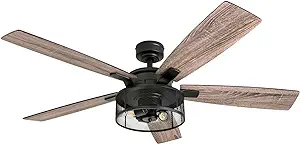
|
Honeywell Ceiling Fans Carnegie, 52 Inch Industrial Style Indoor LED Ceiling Fan |
with Light, Remote Control, Dual Mounting Options, 5 Dual Finish Blades, |
$111.60 |
|
Best Seller

|
Hunter Fan Dempsey Low Profile Indoor Ceiling Fan |
with LED Light and Remote Control, Metal, Fresh White, 44 Inch |
$134.99 |
|
Best Seller
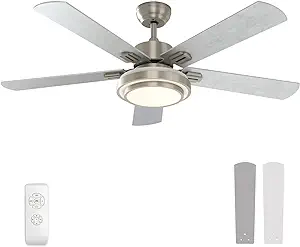
|
warmiplanet Ceiling Fan with Lights Remote Control |
Fan with Lights Remote Control, 52 Inch, Brushed Nickel (5-Blades) |
$139.99 |
|
Best Seller

|
VONLUCE Ceiling Fans with Lights, 52 Inch Modern Ceiling Fan and Remote |
6 Speed Reversible Quiet DC Motor, Ceiling Fan for Bedroom Patio, Indoor & Outdoor, Black |
$119.99
|
Key Considerations:
1. Ceiling Fan Mounting Alternatives:
There are a few mounting options to consider when putting a ceiling fan on a vaulted ceiling:
Standard Mount: Suitable for ceilings with a slight incline.
Angled Mount: For moderately slanted ceilings. It enables the fan to hang upright and function properly.
Extension Rods: These are used to lower the fan from the vaulted ceiling to an acceptable height.
2. Clearance of Ceiling Fan Blades:
Ensuring adequate space between the ceiling fan blades and the ceiling is critical for effective and safe operation. Even if the ceiling is slanted, the blades should be at least 7 feet above the floor.
3. Ceiling Height and Fan Size:
Choose a ceiling fan that is appropriate for the size of the space and the height of the ceiling. Because vaulted ceilings frequently imply larger areas, choose a fan with a blade spread appropriate for the room’s proportions.
Installation Procedure For Vaulted Ceiling Fan:
The fundamental procedures you can use to mount a fan are as follows:
- Measure The Ceiling Angle:
Place a spirit level on the ceiling to measure the angle of the ceiling before you do anything else. The vertical distance between the level and the ceiling should then be measured. After that, check the ceiling fan’s instructions to ensure you have the correct measurements and fan size for your ceiling.
- Turn Off The Electricity And Put The Fan Box In:
To avoid electric shock, turn off the room where the ceiling fan will be installed next. You can do this in the basement of the house, in the breaker box. In the old fan and strut box from the ceiling, and then. After that, remove the new fan mounting box and mount it to the ceiling with a driver.
Pass the wire through a box to hang freely in the hole. Remember that you might need to rotate the shaft of the box to attach the brace to the frame if the ceiling pitch is steep.
- Install A Cable Bracket:
After that, install the wire hanger through the new fan’s hanging bracket, the box, and onto the saddle bolt. The nuts should then be tightened to secure the box to the shaft. With the aid of a socket or socket wrench, it can be tightened. Make sure the vaulted ceiling’s rising side is where the suspended ceiling is located.
- Hang The Fan:
Install the motor housing on a new fan. Once the motor is positioned correctly, insert the bottom bar, thread the wire through it, and clip it to the mounting collar.
Ensure the bottom bar is securely placed before inserting the cotter pin and sliding it through the collar. After that, use lock nuts and bolts to secure the down rod to the hardware pack. Make sure to tighten all nuts and bolts as it is one of the leading causes of Fan Wobbling.
- Connect The Wires:
Take a quick look at the fan diagram before connecting the electrical wiring installing the fan and motor housing, and setting up the wiring and switches.
Remember that the ground wire is typically green, and neutral is usually white. Typically, live wires are blue or black. Don’t forget to match the colors (that is, white wire to white wire, black wire to other black wire, etc.).
- Attach The Fan Blades To The Ceiling:
The blade fan and bracket should then be inserted into the motor housing. It might be necessary to screw the frame into the blade before attaching it to the fan because this is tricky. The ideal tool to use when carrying out this procedure is a drill.
- Join The Receiver And Light Housing:
Install the fan’s lamp housing and radio receiver at this time if your fan has a light and remote control. You must adhere to the fan’s instructions to properly configure the receiver’s code switch and connect it to the electrical wall switch and remote control.
- Turn On The Power And Check The Fan:
Please turn on the power and test the fan to ensure it operates correctly after assembling the receiver and lamp housing. Run the fan for 10 to 15 minutes while keeping a close eye on it to ensure it is not wobbling or appearing unbalanced.
How Low Should The Ceiling Fan Be Mounted On A Vaulted Ceiling?
A ceiling fan’s standard height is 12 inches with a vaulted ceiling. This means that for the fan to operate safely on the ceiling, the downrod must be at least 12 inches long. This must be confirmed when reading the ceiling fan description because you must know the necessary length before installing.
Can Down Rods Be Used With Any Ceiling Fan?
No. However, most ceiling fans include a piece that can be fastened to a down pole. However, if the fan is only meant for flush mounting, it might not come with extra hardware like fan adapters or mounting brackets for down rods.
How Can I Choose the Right Size Ceiling Fan?
Before making a purchase, you should be familiar with the room’s specifications where you intend to install a ceiling fan. If your ceiling is not flat, you should measure the room’s square feet, ceiling height, and angle. Pick the right size before installing a ceiling fan on a vaulted ceiling.
The diameter of the ceiling fan affects its size. The distance between the fan mount’s center and the blade’s edge is known as the fan diameter. This is significant because the space does not require extensive or excessively powerful fans. Additionally, make sure the fan has enough power to cool the room.
Depending on the size of the room, the following recommended fan sizes should be used:
8ft x 12ft Room – 40inch Fan 12ft x 14ft Room – 42inch to 54inch Fan 18ft x 20ft Room – 52inch to 60inch Fan Room Length and Width.
Also check: 5 Good Reasons To Put A Ceiling Fan In Kitchen.
Conclusion:
We hope this article helped describe Can You Put A Ceiling Fan On A Vaulted Ceiling. Keep in mind that precise measurements of the ceiling slope enable you to install your fan safely. To ensure a proper and secure fan installation, always refer to the instructions and recommendations provided by the fan manufacturer.
FAQs
Where should a ceiling fan be installed in a vaulted ceiling?
Keep the blade at the angle you install your fan at least 18 inches away from the nearest wall. Furthermore, the ceiling fan should be installed at least 7 feet above the ground, preferably 8 to 9 feet.
Do vaulted ceilings complement ceiling fans?
Because ceiling fans should be installed eight to ten feet above the floor, an extension rod on the fan shaft will extend the fan’s reach in a vaulted ceiling room. Wide paddles will improve air circulation and efficiently cool the space.
What type of ceiling fan should be used with vaulted ceilings?
On the other hand, a 42-44-inch fan can usually fit in a small room with a vaulted ceiling. Depending on the layout of the room and the ceiling height, you might be able to get away with a 60-inch ceiling fan. For a large area with a sloped ceiling, there are options up to 96 inches.
A vaulted ceiling serves what purpose?
Vaulted ceilings in a room draw the eye upward and emphasize an abundance of open space, making the room appear larger and airier. Vaulted ceilings can create the illusion of a larger room even when the floor area is small, which is useful for smaller floor plans.

